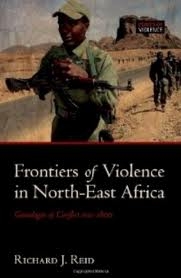|
Reviewed by David J. Ribner MA, JD, ASMEA Member, Associate, O’Melveny & Myers LLP Conflict in northeast Africa has become an ever-present state of regional affairs. In Sudan, there has been genocide in Darfur and fighting stemming from unresolved issues surrounding the independence of South Sudan. Ethiopia still faces internal problems in the Oromo territories and with the Somali in the Ogaden. Eritrea has unresolved borders disputes with Ethiopia and Djibouti. Finally, Somalia is still caught in what appears to be a perpetual cycle of violence. Scholars of the region analyzing the many conflicts often look to recent events to explain the fighting. Richard J. Reid, a reader in history of Africa at the School of Oriental and African Studies, University of London, takes a different approach and attempts to explain the current state of affairs in the region through a historic lens. In Frontiers of Violence in North-East Africa: Genealogies of Conflict Since 1800, Reid argues that the region’s troubled present is rooted in a troubled past stemming largely from an interconnected network of violent frontier zones. For Reid, the current conflicts have a genealogy that can be traced back through the 19th century. Since at least 1800, the region has experienced cyclical patterns of hegemony and subjugation, and the creation of militarized communities and identities. He argues that much of what has happened in the past 20 years represent a “continuation of, or a reversion to, well-established precedent in terms of intra-regional relations, at the level of state, ethnicity, and locale.” In particular, Reid focuses on the concept of “Frontiers of Violence,” that is, the rough contested edges of the region, which are ostensibly on the periphery, advance on the center fueling a continuous state of violence, and an organic and restless militarism. In both Eritrea and Ethiopia, for example, conflicts that began on the peripheries captured the state. Reid’s primary case study for his thesis is Ethiopia. The book provides an historical overview of the Ethiopian empire-state focusing in particular on the emperors Tewodros, Yohannes, and Menelik and the dynamic between the Amhara and Tigrayans. Through this history, he argues that the 19th century was an era in which violence had primacy in Ethiopian political culture, which became both cumulative and self-perpetuating. This culture of violence then carried through to the reign of Haile Selassie, the Derg, and Meles Zenawi’s presidency as a tool to centralize Ethiopian unity. Interestingly, Reid believes that colonialism in the region was not a transformative experience. Rather than viewing the Italian colonial presence as a root cause of the violence between Ethiopia and Eritrea, he views the Italians as having been co-opted into a larger, more ancient struggle. According to Reid, Italy’s drawing of the border between Imperial Ethiopia and Italian Eritrea was merely a recognition of a pre-existing set of borderlands. And it is the border between Eritrea and Ethiopia where Reid considers the epicenter of the region’s instability to lie. In his view, the war between the two states, beginning in 1998, was a manifestation of a pattern of violence both within and around the Eritrean zone dating to the middle of the 19th century. It is part of a long war, not an independent conflict. Further, the conflict between Ethiopia and Eritrea has become connected to other conflicts in the region. Whatever Ethiopia’s interest in the region, Eritrea has lent support to the other side, for example, in Somalia. Thus, every conflict represents another regional states foreign policy opportunity, which perpetuates the regional violence. Readers should be aware of two aspects of the book before picking up a copy. First, while the title refers to northeast Africa, Ethiopia and its frontiers of violence are the work’s primary focus, including Ethiopia’s relationship with Eritrea. Sudan, Somalia, and Djibouti are discussed mainly as they relate to the Ethiopian historical narrative and not as independent subjects of study. Second, the book is very scholarly and assumes more than a basic familiarity with Ethiopian history as well as the details of the many regional conflicts. I would recommend the book as advanced reading but not as a primer. In sum, Reid’s Frontiers of Violence in North-East Africa is a worthy contribution to the scholarly literature of Ethiopia and its neighbors, and introduces necessary historical insight into the conflicts that plague the region. |


 Frontiers of Violence in North-East Africa: Genealogies of Conflict since 1800
Frontiers of Violence in North-East Africa: Genealogies of Conflict since 1800 